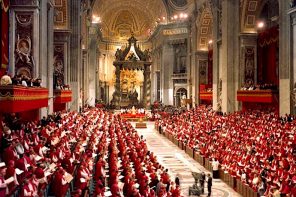On Monday, December 20 of the year just past, Pope Benedict XVI met in the Vatican’s Regia Hall with his College of Cardinals and members of the Roman Curia for the traditional exchange of Christmas greetings. This ceremony has become one in which the Supreme Pontiff reflects on the meaning of the past year, by highlighting what he recalls as most significant in it. The Pope’s reflections on this occasion were reproduced in L’Osservatore Romano in the last edition of the year.
Pope Benedict XVI began with the liturgical formula, Excita, Domine, potentiam tuam, et veni (“Raise up your power, oh God, and come”). He speculated that this liturgical formula was probably a product of the declining years of the Roman Empire, and he meditated on the many ways in which those times are like these times. “The sun was setting over an entire world,” he observed, and the end of that world seemed foreshadowed in disasters both natural and man-made.
Christians, we should recall, were on yet ascendant in that world, since the power of their God had not yet risen up over it.
In that spirit of brooding retrospect, the Pope, to his credit, turned to what should clearly be a dominant concern for this papacy in this somber time: what he called (echoing Revelation) “the great tribulations to which we have been exposed during the past year.”
First on his list of such tribulations, and made damningly ironic in this, the Vatican’s self-styled Year for Priests, is the fact that “in this year of all years and to a degree we could not have imagined, we came to know of the abuse of minors committed by priests who twist the sacrament into its antithesis, and under the mantle of sacred protection profoundly wound human persons in their childhood.”
Benedict is to be credited for speaking as candidly and as often as he has done about such things. And he seemed to intensify his spirited concern by rehearsing a vision from Hildegaard of Bingen, one in which the Church appeared to her as sullied, diseased, and literally torn apart. The blame for the Church’s state lay with none other than her priests. In that vision, Benedict concludes, the Church “is stained with dust, and this is how we have seen it. Her garment is torn–by the sins of priests.”
But then the Pope’s address took an unexpected turn. The Church is not only a victimizer; she is victim as well. And in his judgment, she is victim first and last. These priestly misdeeds are in his view symptoms of a far wider cultural disease afflicting the west, one that has generated an explosive market for child pornography, prostitution that turns bodies into commodities, and a drugs that teach us that “no pleasure is ever enough.”
In other words, the Church was a victim of the hedonistic spirit of the 1960s. Benedict makes this rather surprising conclusion most explicit.
In the 1970s, paedophilia was theorized as something fully in conformity with man and even with children… It was maintained—even within the realm of Catholic theology—that there is no such thing as evil in itself or good in itself. There is only a “better than” and a “worse than”. Nothing is good or bad in itself. Everything depends on the circumstances and the end in view… Morality is replaced by a calculus of consequences, and in the process it ceases to exist. The effects of such theories are evident today.
It is telling that no sources or examples are cited to substantiate these rather surprising claims.
So we find the scandal of priestly abuse turned into a veritable proof-text for this Pope’s diagnosis of the ills of the modern world, ills that the 1960s exacerbated—the ethos of the Second Vatican Council, we should recall. Benedict XVI gestures appreciatively to his predecessor, John Paul II, who first named this illness for what it was.
And now the Pope’s reflections took a truly stunning turn. In a dizzying rhetorical flourish, the image of a victimizing Church hierarchy morphs into that of a victimized Christian community over which this Pope stands as shepherd. When the Supreme Pontiff turns his gaze away from long-suffering EuroAmerica, and focuses his gaze on the Middle East instead, a very different picture comes into view.
In a year where religious tolerance and peaceful pluralism have been major papal themes, the Pope now declares that “Christians are the most oppressed and tormented minority” in present circumstances, worldwide. This is a stunning conclusion, and we have not one word about what metric Benedict has used to draw it. He contents himself with several horrifying anecdotes about Christians massacred at Mass in Baghdad, and a spiking trend of Islamic anti-Christian violence that he insists must be named as such in order to be confronted and defeated. He even coins a term for the current situation: it is “Christianophobia.”
In this not-so-casual address, Benedict XVI seems to link these two phenomena, a cultural crisis that infected the Church in the 1960s and left it vulnerable to new and more violent pressures from outside. The choice of words like “tribulation,” and several explicit citations from the book of Revelation are calculated and deliberate: “The very future of the world is at stake.”
There seems little doubt that the Pope is in earnest. His anti-modern credentials have been firmly established and he has spoken for decades against the Church’s accommodation of the modern world, as symbolized in the free-wheeling spirit of the 1960s and Vatican II. But the rhetorical and argumentative bait and switch evident here is both telling and worrisome.
Pope Benedict XVI seems to have borrowed an important ploy from the broader neo-traditional and neo-conservative culture on the rise worldwide: appropriating the critical tools of the left when they suit your purposes and claiming the mantle of victim as a mode of self-defense.
So we see the Pope’s year-end reflections turn on a dime: an image of the priestly abuse of their sacerdotal role is transformed before the wondering eyes of College and Curia into an image of prayerful Christians massacred at Mass. The Church has been victimizer. But the Church is victim. The Church is in fact the most embattled victim, worldwide. Thus the times are analogous to the end of the western Roman empire, a time when Christians were similarly besieged.. But from which they emerged triumphant.
Clearly, this Pope sees a battle in the offing, and he is reminding the faithful of the divine power enlisted on her behalf. Excita, Domine, potentiam tuam…
It is a deeply worrisome message couched in the apparently benign language of liturgy. And it betrays a refusal of responsibility, since the Christian Church is more victim than victimizer, in the end.




